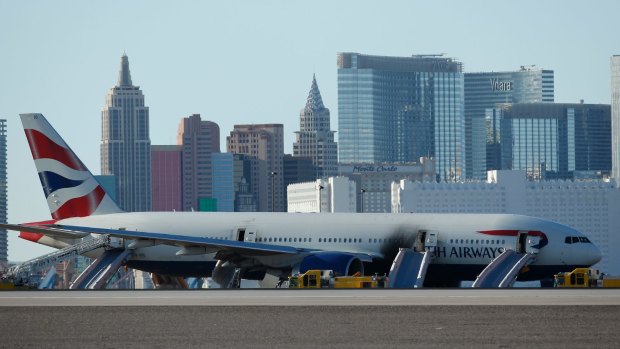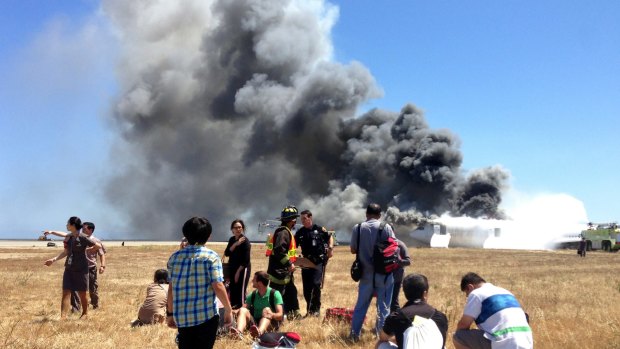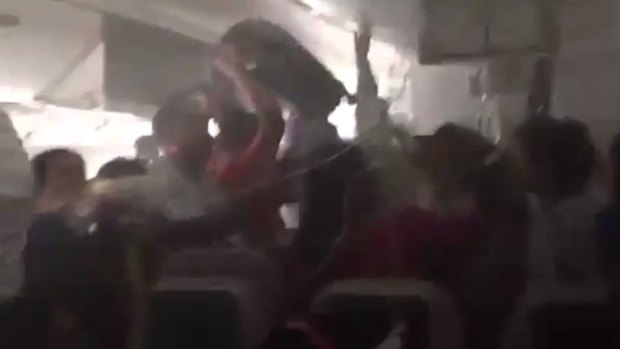This was published 5 years ago
Aircraft emergency evacuation procedures: Passengers risk lives by taking carry-on luggage

When an engine on a Boeing 777, operated by British Airways, caught fire as the aircraft was on its take-off roll at Las Vegas, all 170 passengers and crew were safely evacuated.Credit: AP
How long do you reckon it's going to take to evacuate an aircraft in an emergency? That's every passenger and crew member, out of their seats and down the evacuation slides, starting from the time the emergency exits pop open to the time when the cabin is completely empty. In a smoke-filled cabin with the aircraft on fire, and possibly with some of the emergency exits blocked or unusable. Considering there are probably some wheelchair passengers on board, plus solo parents with babies and infants. Two or three minutes, maybe longer?
How about 90 seconds? Because 90 seconds is the time required for an aircraft with a seating capacity of more than 44 passengers to achieve certification by Europe's Joint Aviation Regulations or the Federal Aviation Regulations in the USA.
To demonstrate compliance, an aircraft manufacturer must perform a full-scale evacuation demonstration, in darkness, with half the available exits blocked and with a gender mix as close as possible to that on a typical flight. Crew and passengers don't know which exits will be blocked and all passengers and crew are expected to be out of the aircraft and on the ground within 90 seconds. If not, the aircraft can't be certified as a commercial aircraft.

Passengers from Asiana Airlines flight 214, many with their luggage, on the tarmac just moments after the plane crashed at the San Francisco International Airport in San Francisco. Credit: AP
Despite every attempt to create a realistic scenario, the demonstration is a long way short of the life-threatening situation that is likely to be unfolding in a real-life emergency evacuation.
The evacuees in the demo know they're going to have to make an emergency evacuation. They're prepped for it, and probably far more aware of where the emergency exits are than is the case among passengers on a typical flight. They are not sitting on an aircraft which might have just skidded along the runway after its landing gear collapsed, shredding screaming metal. There's no choking, eye-watering smoke in the cabin, the aircraft isn't burning, no blind panic and no passengers screaming hysterically. In a YouTube video of an A380 evacuation test, the 873 "passengers" are almost universally young, slender and agile. No babies, no kids, no elderly, incapacitated or intoxicated passengers.
The miracle, then, is that many stricken aircraft that are beset by flames and smoke, having just come to a halt after screeching and tearing themselves to bits along the runway and burdened with passengers who are not in their prime, do in fact manage to get everyone on board safely off in something very close to 90 seconds.

Images posted on social media in 2016 showed passengers scrambling to get their luggage from overhead compartments while their plane was on fire after landing in Dubai.Credit: Twitter/@rehanquereshi
When an Emirates Boeing 777 crashed and caught fire at Dubai Airport in 2016, all 300 passengers and crew were evacuated safely despite only half the emergency slides being deployed before the aircraft was engulfed in flames.
In 2013 an Asiana 777 crashed short of the runway at San Francisco, causing the landing gear, engines and tail section to separate from the fuselage which bucked and pivoted wildly as it skidded along the runway. Despite many injuries from the crash, fire outside and smoke inside the cabin, 305 of the 307 on board survived. The two who died in the crash were found not to be wearing seatbelts.
When an engine on yet another Boeing 777, operated by British Airways this time, caught fire as the aircraft was on its take-off roll at Las Vegas, all 170 passengers and crew were safely evacuated, although 27 required hospital treatment for minor injuries.
In all three cases emergency evacuation procedures proved effective, yet a common thread has emerged from these incidents that deeply disturbed flight crew, aviation regulators and crash investigators. In each disaster, images showed a number of passengers leaving the aircraft having retrieved their carry-ons from the overhead lockers.
This was despite the commands of crew members to passengers to get out of the aircraft and leave their bags behind. Among the items that passengers took with them were handbags, wheeled cases, backpacks and even duty-free alcohol. Some even stopped to grab a selfie, or to shoot video of the unfolding drama on their smartphone while still inside the aircraft.
Apart from delaying other passengers attempting to reach the emergency exits, and slowing down their owners, carry-ons present an additional threat to the inflatable slides that deploy automatically from these exits.
One solution that has been suggested is overhead baggage compartments that lock shut in an emergency. However, the prospect of some enraged and panicked passengers slamming at the overhead lockers while trying to free their precious gear – and holding up everyone behind – is not the desired effect. It's behaviour that needs adjusting, not the hardware. Perhaps requiring passengers who have retrieved their carry-ons to return them to the overhead lockers of their stricken aircraft could be a more effective deterrent.
See also: The airlines that have never had a single crash
See also: Plane secrets: 10 things on an aircraft you never knew about
Sign up for the Traveller newsletter
The latest travel news, tips and inspiration delivered to your inbox. Sign up now.